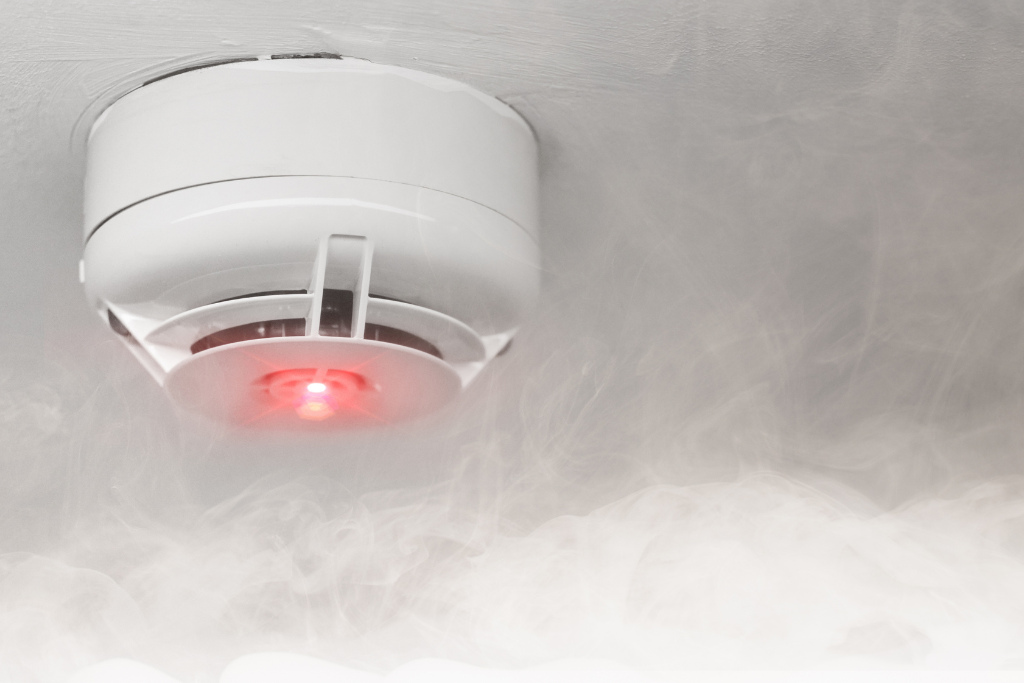Ultimate Guide to Wireless Fire Alarm Systems

Looking to protect your building from potential fire hazards? Well, Wireless fire alarm systems are here to save the day.
Imagine having a reliable and flexible solution that ensures the safety of your property and its occupants. With wireless fire alarm systems, you can achieve just that. These innovative systems utilize wireless technology to communicate between devices, eliminating the need for extensive wiring.
Not only are they easy to install, but they can also be customized to fit the specific needs of any building. Whether it’s a small residential property or an ample commercial space, wireless fire alarm systems have got you covered.
By incorporating wireless technology and creating a seamless network of connected devices, these systems provide efficient fire detection with minimal hassle. Plus, they offer additional features like intrusion detection and can be integrated with other security measures.
So why risk it when you can have peace of mind? Upgrade to a wireless fire alarm system today and ensure the utmost safety for your property and everyone inside.
Linked Security NY: Prioritizing Safety with Wireless Fire Alarm Systems Collaboration
Safety and security are paramount when it comes to protecting your property. While Linked Security NY is renowned for its excellence in numerous security solutions, it’s essential to note that we are not licensed for Wireless Fire Alarm Systems. However, this has never deterred us from ensuring the utmost safety for our clients. Whenever the need arises for such systems, we collaborate with trusted third-party companies, ensuring that the highest security standards are met.
We pride ourselves on our commitment to client satisfaction and safety. Our robust partnerships allow us to provide wireless fire alarm solutions that perfectly blend convenience with cutting-edge security. The assessments we conduct on properties, in collaboration with our partners, guarantee that each system is meticulously designed to offer unparalleled protection.
By partnering with Linked Security NY, you’re not just receiving a solution; you’re gaining an assurance. We prioritize your safety, and through our collaborations, we bring together the best of both worlds—our dedication and expertise, coupled with specialized skills from our trusted third-party associates. Rest assured, our combined efforts aim to provide you with optimal peace of mind.
How Wireless Fire Alarm Systems Work
Wireless fire alarm systems have revolutionized the way we detect and respond to fires. These advanced systems utilize radio frequency signals to transmit crucial information between devices, ensuring swift communication during emergencies. Let’s delve deeper into how these wireless fire alarm systems function.
Radio Frequency Signals for Communication
In a wireless fire alarm system, each device acts as a node that sends and receives signals from other devices within the network. These nodes communicate through radio frequency signals, allowing for seamless transmission of data across the system. This wireless nature eliminates the need for complex wiring installations, making it easier and more cost-effective to implement such systems in various settings.
Alerting the Control Panel
When smoke or heat is detected by a device within the wireless fire alarm system, it promptly sends an alert signal to the central control panel. This control panel serves as the brain of the entire system, constantly monitoring incoming signals from all connected devices. Once an alert is received, the control panel triggers alarms and notifications throughout the premises to warn occupants about potential danger.
Swift Response in Emergencies
One of the key advantages of wireless fire alarm systems is their ability to facilitate quick and efficient communication during emergencies. Traditional wired systems often face limitations due to physical constraints like walls or ceilings obstructing signal transmission. However, with wireless technology, these barriers are overcome as signals can easily travel through open spaces, ensuring reliable communication even in large buildings or complex layouts.
Moreover, wireless fire alarm systems offer flexibility. Since there are no wires involved, installation becomes hassle-free without disrupting existing structures. This adaptability allows businesses and homeowners alike to customize their fire protection setups according to evolving needs.
Enhanced Safety Features
Wireless fire alarm systems come equipped with additional safety features that enhance overall protection against fires. For instance:
- Some systems include battery-powered devices that continue functioning even during power outages, ensuring uninterrupted monitoring.
- Advanced systems utilize multi-sensor detectors capable of detecting both smoke and heat, providing more accurate and reliable fire detection.
- Wireless fire alarm systems can be integrated with other safety devices such as sprinkler systems or emergency lighting, creating a comprehensive safety network.
Comparison of Market-available Wireless Fire Alarm Systems
The market offers a wide range of options with different features and capabilities. It is crucial to compare these systems based on your specific requirements before making a decision. Let’s explore some key points when evaluating the available wireless fire alarm systems.
Advanced Monitoring Options
One important aspect to look for in wireless fire alarm systems is advanced monitoring options. Some systems provide remote access through mobile apps or cloud-based platforms, allowing you to monitor your property from anywhere at any time. This feature can be especially beneficial for businesses or homeowners who travel frequently or have multiple locations to manage. With remote access, you can receive real-time notifications, view live camera feeds, and even control various aspects of the system remotely.
Battery Life and Device Support
Another factor worth considering is the battery life and device support offered by different wireless fire alarm systems. Longer battery life ensures that your system remains operational even during power outages or when batteries are not easily accessible. Some systems support a larger number of devices within a single network, which can be advantageous for larger properties or buildings with complex layouts.
Cost Considerations
While comparing wireless fire alarm systems, cost is an essential factor to take into account. The price of these systems can vary significantly depending on their features and capabilities. It’s important to strike a balance between affordability and functionality when choosing a system that fits your budget without compromising on safety.
By carefully evaluating these factors and comparing the wireless fire alarm systems on the market, you can make an informed decision that meets your specific needs. It’s crucial to prioritize safety while considering factors such as advanced monitoring options, battery life, device support, and cost.
Remember, investing in a reliable wireless fire alarm system is essential for ensuring the safety of your property and the people within it. Take the time to research and compare different systems before making a final choice.
Compliance of Wireless Smoke Detectors with Fire Safety Codes
Wireless smoke detectors are an integral part of any fire alarm system, ensuring the safety of occupants in various environments. However, it is crucial to understand that these detectors must comply with relevant fire safety codes and standards to meet specific performance criteria. By choosing certified wireless smoke detectors from recognized testing laboratories, you can ensure compliance with regulations and trust that your wireless fire alarm system meets industry standards.
Fire safety codes are established to safeguard lives and property by setting forth requirements for fire protection systems. These codes outline the necessary measures to prevent fires, detect them early, and provide adequate time for evacuation. Compliance with these codes is essential as they play a critical role in alerting occupants about potential dangers.
One of the primary reasons why compliance is crucial is because safety requires adherence to specific requirements. Fire safety codes specify the minimum performance criteria that wireless smoke detectors must meet. These criteria may include factors such as sensitivity levels, response times, and reliability. By complying with these requirements, wireless smoke detectors can effectively detect the presence of smoke or fire promptly.
Moreover, compliance ensures that wireless smoke detectors are suitable for use in different environments. Fire safety codes consider factors like temperature variations, humidity levels, and potential interference from other electronic devices. By adhering to these standards, manufacturers design wireless smoke detectors capable of operating reliably under various conditions.
To ensure compliance with regulations, it is vital to choose wireless smoke detectors certified by recognized testing laboratories such as Underwriters Laboratories (UL) or Intertek’s ETL Mark program. These certifications indicate that the detectors have undergone rigorous testing procedures and have met all necessary standards for performance and safety.
By using compliant wireless smoke detectors in your fire alarm system, you can trust that you have taken the necessary steps to protect life and property. Compliance not only ensures that your system meets industry standards but also provides peace of mind knowing that your wireless smoke detectors have been thoroughly tested and approved by reputable organizations.
Exploring the Components of a Wireless Fire Alarm Systems
A wireless fire alarm system is an essential safety feature in any building, providing early detection and warning in the event of a fire. Understanding the components of such a system is crucial for ensuring its effectiveness. Let’s delve into the key elements that comprise a typical wireless fire alarm system.
Smoke Detectors: The Guardians Against Fire
Smoke detectors are at the forefront of fire detection in wireless alarm systems. These devices play a pivotal role in safeguarding lives and property by actively monitoring the air for smoke particles. Equipped with advanced sensors, smoke detectors can swiftly detect even minute traces of smoke, triggering an immediate alert.
Heat Detectors: Sensing Temperature Changes
In areas where smoke detectors may not be suitable due to high levels of dust or fumes, heat detectors come into play. These devices sense temperature changes and activate alarms when they exceed predetermined thresholds. By complementing smoke detectors, heat detectors provide comprehensive coverage for different types of environments within a building.
Control Panels: The Central Hub
Control panels act as the nerve center of a wireless fire alarm system. They receive signals from all connected devices and orchestrate appropriate responses based on preprogrammed protocols. When an alarm is triggered by a smoke or heat detector, control panels activate audible and visual alarms, notifying occupants about potential danger.
Sirens and Visual Alarms: Ensuring Prompt Response
Sirens and visual alarms are crucial components that alert people within a building to evacuate immediately upon detecting signs of fire. Sirens emit loud sounds to capture attention while visual alarms use flashing lights to ensure visibility even in noisy environments or situations where hearing impairment may be present.
Repeaters: Extending Coverage Range
In larger buildings or structures with complex designs, repeaters become indispensable elements of wireless fire alarm systems. These devices amplify signals between various components, ensuring seamless communication across vast areas. By extending the coverage range, repeaters eliminate blind spots and guarantee that every corner of the building is protected.
A wireless fire alarm system encompasses more than just these primary components. It also includes additional devices such as call points and access control systems to enhance overall safety and security. Regular testing and maintenance of the system are crucial to ensure its proper operation during emergencies.
Understanding the Benefits of Wireless Fire Alarm Systems
Wireless fire alarm systems have revolutionized the way we approach fire safety in buildings. With their increased flexibility during installation, these systems offer a range of benefits that make them an ideal choice for both new constructions and retrofitting existing buildings.
Increased Flexibility during Installation
One of the key advantages of wireless fire alarm systems is the ease and flexibility they provide during installation. Unlike traditional wired systems, which require extensive wiring through walls and ceilings, wireless systems eliminate this need. This means that when installing a wireless system, there is no disruption to the building’s structure or aesthetics.
Retrofitting existing buildings with a wired system often involves invasive work that can damage walls or ceilings. However, with wireless fire alarm systems, this concern has become a thing of the past. Whether it’s an office building or a historical structure, wireless systems can be seamlessly integrated without compromising the integrity of the architecture.
Reliable Communication without Physical Connections
Wireless fire alarm systems rely on advanced technology to establish reliable communication between devices without physical connections. This eliminates concerns about deteriorating wires or faulty connections over time. By using radio frequency signals to transmit information between components such as smoke detectors, control panels, and sirens, these systems ensure quick and accurate detection of potential fires.
The absence of physical connections also allows for greater flexibility in device placement. With wired systems, devices must be strategically located near wiring access points. In contrast, wireless components can be easily installed in optimal locations for maximum effectiveness without being constrained by wiring limitations.
Enhanced Safety Measures with Cost-Effective Installation
Wireless fire alarm systems provide an excellent solution while minimizing installation costs. The elimination of extensive wiring significantly reduces both labor and material expenses associated with traditional wired installations.
Moreover, wireless systems are highly scalable and adaptable to changing needs. Additional devices can be easily incorporated into the system without the need for extensive rewiring. This flexibility is particularly advantageous in large buildings or complexes where expansion or reconfiguration may be required.
By opting for wireless fire alarm systems, building owners can enhance safety measures while keeping installation costs under control. These systems offer seamless integration, reliable communication, and the ability to adapt to evolving requirements.
Conclusion: The Benefits of a Wireless Fire Alarm Systems
Congratulations! You’ve now gained a comprehensive understanding of wireless fire alarm systems and their numerous advantages. By opting for a wireless system, you can enjoy the benefits of easy installation, flexibility in placement, and simplified maintenance. With no need for drilling or extensive wiring, you can have your system up and running in no time. Plus, the ability to place detectors wherever needed ensures optimal coverage throughout your property.
Not only are wireless fire alarm systems compliant with fire safety codes, but they also offer advanced features like remote monitoring and smartphone integration. Imagine receiving instant alerts on your phone in case of any emergency, allowing you to take immediate action even if you’re away from home. By choosing a wireless system, you’re investing in peace of mind and enhanced safety for yourself and your loved ones.
So why wait? Upgrade to a wireless fire alarm system today and experience the convenience, flexibility, and cutting-edge technology it has to offer. Protect what matters most – your family and your home – with a reliable wireless solution that leaves no room for compromise.
FAQs – Wireless Fire Alarm Systems
Are wireless fire alarm systems as reliable as wired systems?
Wireless fire alarm systems are just as reliable as their wired counterparts. They utilize advanced technology to ensure seamless communication between components, providing accurate detection and timely alerts in case of emergencies.
Can I install a wireless fire alarm system myself?
Yes! One of the major advantages of wireless fire alarm systems is their easy installation process. Most models come with user-friendly instructions that allow homeowners to set up the system themselves without professional assistance.
Do I need Wi-Fi for a wireless fire alarm system?
No, you do not need Wi-Fi specifically for a standard wireless fire alarm system to function properly. However, certain advanced features like remote monitoring via smartphone apps may require an internet connection.
How often do the batteries in wireless smoke detectors need to be replaced?
The frequency of battery replacement depends on the specific model and manufacturer. However, it is generally recommended to replace the batteries in wireless smoke detectors at least once a year or as indicated by the manufacturer’s instructions.
Can I integrate a wireless fire alarm system with my existing security system?
Yes, many wireless fire alarm systems are designed to be compatible with existing security systems. This integration allows for centralized monitoring and control, providing comprehensive protection for your property.





